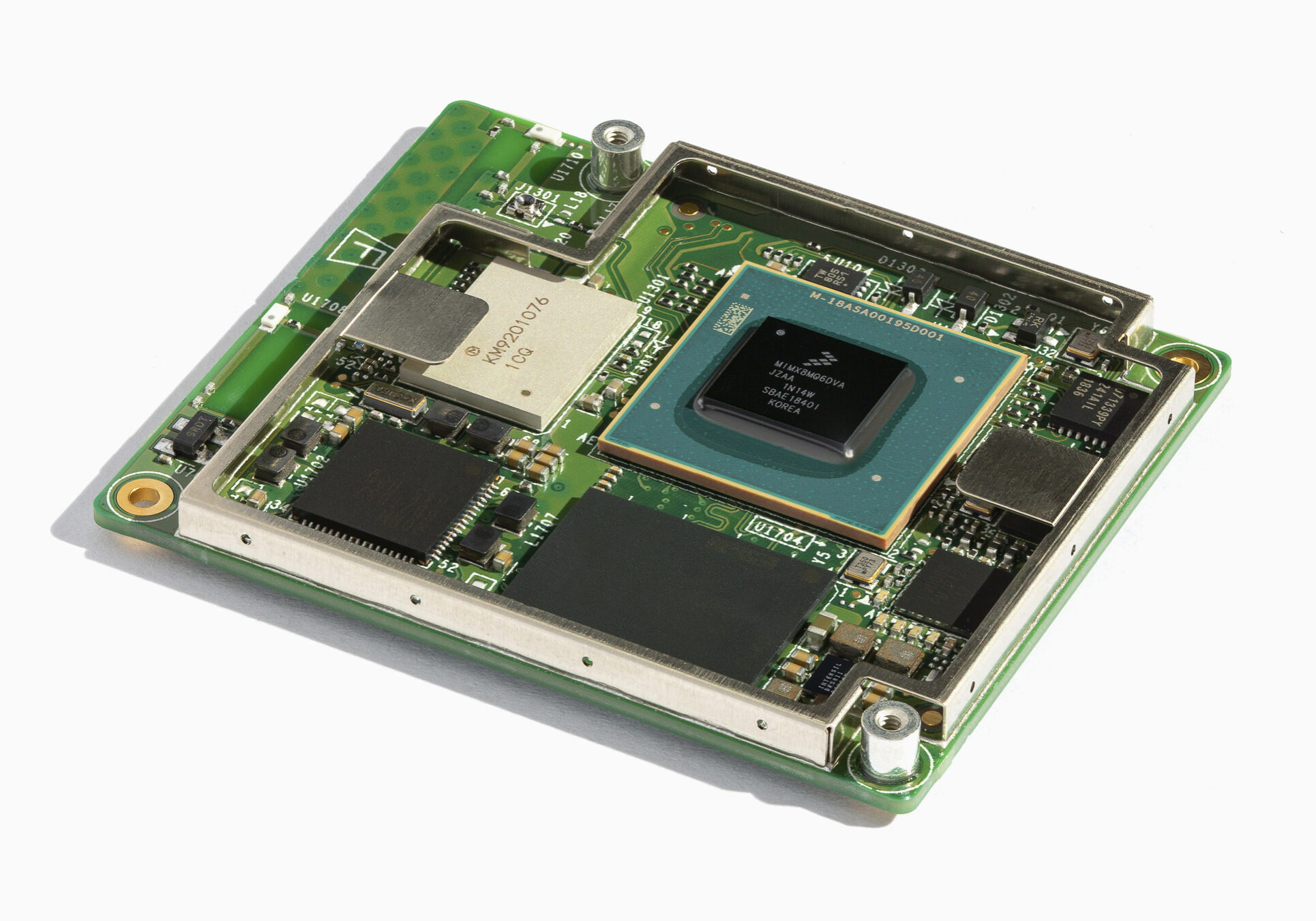The Google Coral System-on-Module (SoM) 1GB is a fully integrated system module for hardware accelerated machine learning applications, consisting of CPU, GPU, Edge TPU, Wi-Fi, Bluetooth, and memory in a small form factor (40mm x 48mm).
This module can be easily designed into your own hardware (and application). For example, it is the core of the Coral Dev Board (in the 4GB variant).
Coral System-on-Module: A fully-integrated system for accelerated ML applications in a 40mm x 48mm pluggable module.
Advantages
- Designing a suitable carrier board for your machine learning application is much more cost effective and faster (compared to building the entire hardware from scratch)
- You get a well-balanced hardware platform with good software support
- The three memory variants allow you to choose the most suitable one for your application - offer options to your customers or optimize costs
Coral SOM
Besides the EdgeTPU, the Google Coral SoM 1GB contains the most important components of an embedded PC:
- NXP i.MX 8M SoC (CPU + GPU)
- Google Edge TPU ML accelerator
- Crypto coprocessor
- Wi-Fi + Bluetooth
- 8 GB eMMC
- 1 GB LPDDR4
- USB 3.0 interface
- Gigabit Ethernet interface
- HDMI and MIPI-DSI
- MIPI-CSI-2
- up to 95 x GPIO (including SPI, I2C, PWM, UART, SAI and SDIO)
In the prototyping stage, you can implement your application using the 4GB Coral Development Board, which is based on this SoM module. Afterwards, you can easily realize your own hardware design optimized for your application to integrate features, target a certain form factor and/or cut manufacturing costs.
The Edge TPU
With the Edge TPU, Tensor Flow Lite models can be run quickly and with low power consumption. A particular advantage of this solution: Your data remains local. This helps with latency, and of course with data protection! (And according to compliance with relevant laws, for example the General Data Protection Regulation (GDPR)).
Google is increasingly using artificial intelligence (AI) and machine learning (ML) to realize its services. To do so, it developed specialized processors called TPU ("tensor processing unit") for its data centers that can run algorithms faster and more energy-efficiently using the TensorFlow framework. For example, Google Maps is enhanced by street signs captured by Street View, which are analyzed using a neural network based on TensorFlow. TensorFlow can be easily programmed in Python.
The Edge TPU supports the TensorFlow Lite framework. The Edge TPU can perform up to 4 trillion computational operations per second with only 2 W consumption. TensorFlow Lite is a modified version of TensorFlow that has been specifically adapted to the needs of mobile devices and embedded devices. Many TensorFlow applications can also be realized in TensorFlow Lite.
Technical Data Coral SOM (system-on-module)
NXP I.MX 8M SoC:
- Quad-Core ARM Cortex-A53 (@1.5 GHz, 64-bit ARMv8-A) + Cortex-M4F
- Vivante GC7000Lite GPU (supports Vulkan), 32 GFLOPs 32-bit or 64 GFLOPs 16-bit
- 4Kp60 HEVC/H.265 main und main 10 decoder
- 4Kp60 VP9, 4Kp30 AVC/H.264 decoder (requires full system power)
- 1080p/60fps MPEG-2, MPEG-4, MJPEG, H.263 decoder
Memory:
- Flash: 8GB eMMC
- RAM: 1GB LPDDR4
- SDIO interface supports boot from SD card (if present in your design)
Edge TPU:
- Google Edge TPU ML accelerator coprocessor
- 4 TOPS (int8); 2 TOPS per Watt
- connected to NXP i.MX 8M SoC via PCIe (Gen2 x1) and I2C/GPIO
Tip: the connection via PCIe enables the maximum transfer rate to the EdgeTPU module, therefore the Coral System-on-Module is especially well suited for applications with high frame rates / high performance requirements.
Network & USB:
The Coral SoM has the following network interfaces:
- Wi-Fi 2x2 MIMO (802.11a/b/g/n/ac 2.4/5GHz),Murata LBEE5U91CQ module
- Bluetooth 4.2 and BLE (Bluetooth Low Energy), Murata LBEE5U91CQ module
- 2x USB 3.0/2.0 controller with integrated PHYs
- 1x Gigabit Ethernet controller, supports EEE, Ethernet AVB, and IEEE 1588, via RGMII (Reduced gigabit media-independent interface)
HDMI interface:
- HDMI 2.0a (standard size), supports a display with up to 1080p resolution
- Upscaling & downscaling between 4K and HD video (uses full system resources)
- 20+ Audio interfaces 32-bit @ 384 kHz fs, with Time Division Multiplexing (TDM) support
- SPDIF input and output
- Audio Return Channel (ARC) via HDMI is supported
MIPI-DSI screen interface:
- MIPI-DSI 4 lanes, supports one display, resolutions up to 1920 x 1080 @ 60 Hz
- LCDIF display controller
- Output: LCDIF or DC display controller output
Audio:
- 1x SPDIF input and output
- 2x synchronous audio interface (SAI) modules, support I2S, AC97, TDM and codec/DSP interfaces
- 1x SAI for 8 Tx channels for HDMI audio output
- 1x SPDIF input for HDMI Arc input
Camera:
- 2 x MIPI-CSI2 camera inputs (4-lane each)
- GPIO interface
- 2x UART interface
- 2x I2C interface
- 2x SPI interfaces
- 16x GPIOs with interrupt capability
- 4x PWM outputs
Connectivity & interfaces: other:
- 1x uSDHC Interface
- IOMUXC (Input/output multiplexing controller) for control of the pads
Hint: the SoM uses some of the SoC GPIOs / interfaces internally, e.g. to connect the Coral Edge TPU. The interfaces listed here already take this into account and are available to you without restriction.
Security:
- Resource Domain Controller (RDC), supports four domains and up to eight regions
- Arm TrustZone (TZ) architecture
- On-Chip RAM (OCRAM) secure region protection using OCRAM controller
- High Assurance Boot (HAB)
- Cryptographic acceleration and assurance (CAAM) module
- Secure non-volatile storage (SNVS): Secure real-time clock (RTC)
- Secure JTAG controller (SJC)
- Crypto coprocessor Microchip ATECC608A
Voltage supply:
The Coral SoM requires a 5 V power supply and generates all other required voltages itself with an on-board PMIC.
Power consumption of the SoM approx:
- idle: 2.6 W
- idle with HDMI output: 3.0 W
- High performance: 6.2 W
Further information:
- Dimensions of the Coral SoM: 40 mm x 48 mm x 5.11 mm
- Weight: 13 g
- Connection to the carrier board: the SoM is connected to the carrier board using three 100-pin connectors (Hirose DF40C-100DP-0.4V)
Software support
Mendel Linux:
Mendel Linux is a Debian derivative developed by Google, specifically for the Coral platform. A boot loader is pre-installed on the SoM, you have to install Mendel Linux manually.
Mendel Linux uses Debian's upstream binary packages to maintain as much compatibility as possible, and to allow security updates in a timely manner. It currently supports only the Coral Dev Boards (also known as "enterprise" or "phanbell") and the Coral SoM modules (System-on-Modules).
Tensorflow lite:
The Coral System-on-Module supports the execution of (compiled) TensorFlow Lite models on its EdgeTPU.
Automl vision edge:
The Coral System-on-Module supports AutoML Vision Edge to quickly deploy image classification models.
Potential for industrial applications
The Google Coral TPU & TensorFlow Lite are a revolutionary product platform for machine learning applications! This enables embedded solutions that can, for example, detect problems with workpieces, recognize traffic situations, and much more.
The Coral SoM (System-on-Module) is suitable if you are aiming for a custom hardware solution that has higher requirements for machine-learning inference speed, and at the same time requires optimized power consumption.
As an alternative to the SoM, which provides its own platform, Coral by Google also offers PCI Express modules and M.2 modules that can extend your existing or new off-the-shelf hardware.
Datasheet
Google part number: G650-04474-01
Asus part number: 90AN00I4-B0XAY0
Additional Legal Information
The products offered by Google are unrelated to the products offered under the CORAL trademarks owned by Orient Development Enterprises Ltd. in Taiwan.




